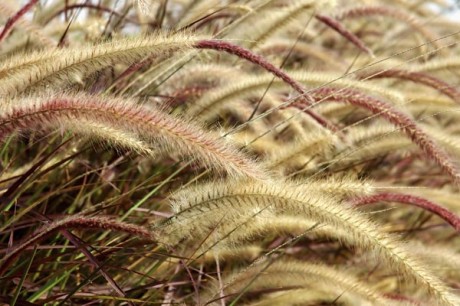Grasses Are More Than Green
There are many pretty ornamental grasses that are easy to love
By Katie Lamar JacksonTo many people, grass is dense, green coverage for the lawn. In fact, there are many varieties of grass that can be used for so much more—to accent landscapes and patios; to add color, texture and sound to the garden.
Long, swaying grasses may be part of a lovely meadow scene; other grasses serve as a home and food source for wildlife; and some can add interest to a winter landscape.
Think pampas, big and little bluestem, prairie dropseed, cord, porcupine, fountain, feather and hair grasses — the names alone suggest the fabulous array of options available for planting, many of which have the added advantage of being native to an area and, thus, environmentally responsible choices.
Ornamental grasses are beautiful and easy to grow and maintain. Give them a home in well-drained soil and sufficient room to grow and they will be happy with hardly any fertilizer or irrigation and only a bit of maintenance.
Grasses of some sort are native to almost every ecosystem, from arctic tundras to arid deserts, and from coastal shores to swamps and wetlands. And "ornamental grasses" aren't limited to just the grass family (Poeceae), but include other grass-like perennials such as sedges, rushes, restios, cat-tails and bamboos.
Assessing the area
To find just the right ornamental grass, begin by assessing the area where they will be used. Determine the lighting and moisture available, then think about what size of plant will work best in that spot. Ornamental grasses range from low-growing groundcovers to giant, towering clumps and come in a wide range of colors and textures, so the only limit is imagination and space. Using only native plants may narrow the options a bit, but there should still be plenty to choose among.
Also, think about what other plants will be included in the area. Will grasses be used with other grasses or with wildflowers, bulbs or bedding plants? Knowing the plant mix you hope to use will help narrow the options.
Now the fun part begins: Choosing the species or cultivars to buy. It helps to see photos, so get a high-quality ornamental grass book, several of which are available at libraries, bookstores and online. Be careful not to pick plants that can become invasive or plants not suited for local conditions. Ornamental grasses should be purchased from reputable dealers as seed, container plants or plugs and bare-root plants. Seed is the least expensive choice but, needless to say, will take a little longer to become established.
Once the grasses are in the ground, keep them well watered and tended until they become established, then sit back and enjoy — no mower needed!
North Carolina landscapes
Residents have many attractive choices for grasses that will thrive here. Dwarf blue fescue (or sheep's fescue) is a favorite for ground cover and good for small gardens. It can be used across North Carolina, as can plume grass and eulalia grass (above). Showy pampas grass (upper left) is hardy throughout the state except in the highest mountain elevations. Weeping lovegrass is popular in eastern North Carolina for eroded areas and slopes. For more ideas, consult with your local garden center or visit North Carolina Cooperative Extension Office's website at www.ces.ncsu.edu for lists and photos.
About the Author
Katie Lamar Jackson is chief editor at the Auburn University College of Agriculture and the Alabama Agricultural Experiment Station.-
Share this story:




